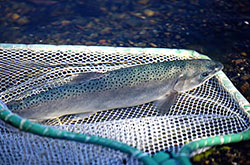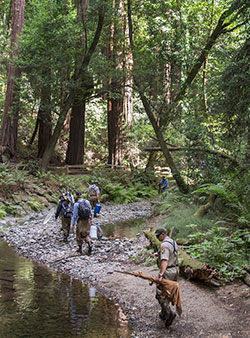
Adult Coho: Adult Coho Salmon released in Salmon Creek, Marin Co. (CDFW photo by Manfred Kittel).

Redwood Creek: CDFW biologists searching for juvenile Coho Salmon in Redwood Creek in summer 2014.
Coho salmon (Oncorhynchus kisutch), also known as silver salmon, have lived in California’s coastal watersheds for thousands of years. Today their populations have declined to just a fraction of historical levels, endangered by a wide range of factors. In Central California in particular, the situation is dire, with the species listed as endangered under both the state and federal Endangered Species Acts. Many populations are in danger of declining to the point of local extinction.
Recognizing the recovery of Coho salmon in central California’s streams and rivers as a high priority, the California Department of Fish and Wildlife (CDFW) is collaborating with NOAA’s National Marine Fisheries Service (NMFS), the U.S. Army Corps of Engineers (USACE), and other partner agencies and non-governmental organizations to develop and implement recovery actions. The tricky part is that there is no one-size-fits-all approach to saving the species.
Eric Larson, Fisheries Program Manager for CDFW’s Bay Delta Region, has monitored the decline of Coho on the Central Coast over the past three decades. As he sees it, an effective conservation strategy will do two things: prevent local extinction events, and implement specific recovery actions in streams that once functioned as Coho strongholds. “But,” says Larson, “each stream is a unique geographic and ecological system. In each watershed, any recovery actions -- including captive rearing and release efforts -- must be custom-tailored to that system to be successful.”
To date, some of those custom-tailored approaches include the following:
Captive breeding and monitoring (Sonoma County). Since 2001, CDFW has been working with NMFS, USACE and others to restore Coho populations in the Russian River basin in Sonoma County. A captive breeding program was developed at Warm Springs Hatchery, situated at Lake Sonoma Dam, to help re-establish populations in Russian River tributaries and other regional streams where Coho once flourished. The hatchery program relies on a genetically informed breeding matrix to minimize inbreeding and conserve genetic diversity. The program produces up to 200,000 Coho annually, which are released primarily as juveniles into tributaries of the Russian River and other streams, although some smolts and adults are also released in a few regional streams.
Concurrently, scientists from the University of California Sea Grant and Sonoma Water have been  actively monitoring juvenile Coho and adults returning to the Russian River system since the hatchery program began. The number of adult Coho returning to the river each year to spawn has gradually increased from just a handful in 2009, to more than 700 in 2017-2018.
actively monitoring juvenile Coho and adults returning to the Russian River system since the hatchery program began. The number of adult Coho returning to the river each year to spawn has gradually increased from just a handful in 2009, to more than 700 in 2017-2018.
Watershed restoration work and hatchery rearing of juveniles (Marin County). CDFW is collaborating with the National Park Service, USACE, State Parks and others to restore Coho salmon in Redwood Creek, which flows through the picturesque Muir Woods National Monument. The prolonged drought from 2013-2016, along with other factors, had brought Coho in Redwood Creek to the brink of local extinction, with fewer than 10 fish returning annually to the creek as adults to spawn.
From 2014 to 2016, approximately 200 juvenile Coho per year were collected in Redwood Creek and taken to Warm Springs Hatchery for rearing. The young salmon were grown to adulthood in the hatchery and, as three-year-old fish, released back into Redwood Creek in the winters of 2016 to 2018 to spawn. Tissue samples taken from juvenile Coho in summer 2017 and genotyped at the NOAA Southwest Fisheries Science Center in Santa Cruz confirmed that several of the fish released as adults in winter 2016 had spawned successfully and contributed to the persistence of this population in Redwood Creek.
Captive rearing (Mendocino County). Farther north, Coho populations are also declining in coastal watersheds such as the Garcia, Gualala and Navarro rivers. In recent years, the numbers of adult Coho returning to the Garcia and Navarro rivers have been below the threshold necessary to maintain viable populations, and no Coho have been detected in the Gualala River at all for several years. This low abundance raised concerns at CDFW and NMFS that without intervention, populations were likely headed towards local extinction.
For this reason, CDFW, NMFS and other partners developed a population recovery plan similar to those used for restoring Coho in the Russian River and Redwood Creek. As a first step, approximately 200 juvenile Coho were collected in October 2018 and again in 2019 in the Garcia and Navarro Rivers and taken to Warm Springs Hatchery. There the juveniles are being reared in captivity under the watchful eye of experienced hatchery staff. Meanwhile, CDFW and NMFS are developing plans for release of these fish, preferably as adults, back into their natal streams to spawn naturally. Although the fish could hypothetically be spawned at the hatchery and their offspring released back into the Garcia River, this option is unlikely due to hatchery space limitations. Releasing the Coho as adults also has the advantage of providing the released mature fish with free mate choice and exposing their offspring to natural selective pressures from the earliest life stage. Importantly, appropriate monitoring activities, including genetic parentage analysis, will be implemented to evaluate the success of the fish releases over the coming years.
The development and implementation of recovery programs, such as those outlined here, are urgently needed to conserve Central California coast coho salmon for future generations to enjoy and to make progress towards population recovery.
You can read more about efforts to conserve California’s Coho in the following documents:
CDFW Photos. Top Photo by Manfred Kittel. Warm Springs Hatchery, adjacent to Dry Creek. Picture taken from the top of Lake Sonoma Dam.
###
Media Contact:
Harry Morse, CDFW Communications, (208) 220-1169